trail Map
Stop 1: ST. IVES: A brief history

Stop 1: ST. IVES: A brief history
(stop 1 of 25)
St. Ives is said to have been established by St. Ia who travelled across from Ireland on a clover leaf.
St. Ives is bounded on three sides by the sea. St. Ives was originally a small fishing village. During the 1800s, it became a prosperous fishing and mining town: The pilchard industry was at its height and the town was surrounded by tin and copper mines. The noise of the mine engines reverberated through the town. Coal was unloaded in the harbour and transported up to the mine engines at the top of the Stennack (Stennack is Cornish for 'place of tin') and Wheal Trenwith (where the leisure centre and car park are now located).
Miners required on-the-go food that would offer maximum .convenience and nutrition. The 'Cornish Pasty' was the perfect solution with its thick crust for the miners to hold, preserving the edible body of the pasty from mining dust and minerals.
The pilchard industry was extremely profitable. St. Ives had around 300 seine boats which netted millions of pilchards. The pilchards were salted and pressed into barrels. They were predominantly exported to Italy and Spain where they were the most popular dish to eat on Fridays and during Lent when meat was forbidden.
Smuggling was thought to have originated as a result of the taxing of salt. As salt was used for preserving pilchards, such a tax had a major economic impact and was greatly resented leading to the smuggling of salt. Smuggling of other goods on which tax was levied, such as alcohol, perfumes, silks and spices, also occurred.
The arrival of the railway in 1877 led to a big change in the town and enabled the development of tourism. The Great Western Railway heavily marketed the Cornish Riviera. During the late 1800's the artists who flocked to St. Ives each year used to hire a complete train carriage to take their paintings to London for the annual Royal Academy exhibition. The mid 1900's saw St. Ives gain its international reputation as an artistic centre led by Barbara Hepworth, Ben Nicholson and Bernard Leach.
The image is an aerial photo of the
historic core of St. Ives bounded by the Harbour (Stop 6), The Island (Stop 13), Porthgwidden (Stop 12) and Porthmeor (Stop 14).
There is a wealth of written information and photographs of old St. Ives at St. Ives Archive (Stop 20), while the St. Ives Museum (Stop 11) is well worth a visit.
Stop 2 – Guildhall & Visitor Information Centre
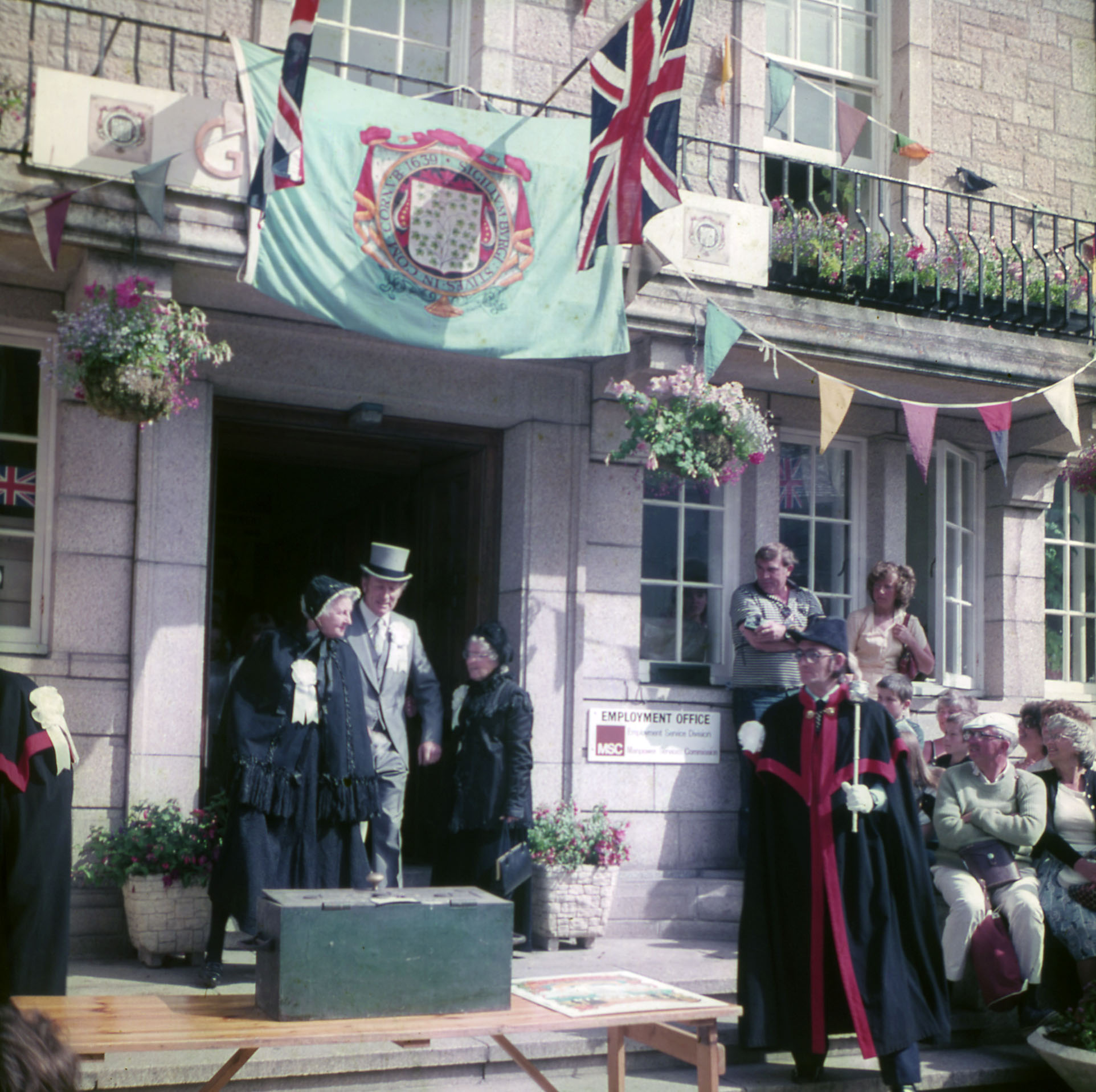
Stop 2 – Guildhall & Visitor Information Centre
(stop 2 of 25)
The Visitor Information Centre is located in St. Ives Guildhall, the home of St. Ives Town Council since it was built in 1939. Outside the Guildhall is a Barbara Hepworth sculpture, 'Dual Form'. Barbara Hepworth was given the Freedom of the Borough of St. Ives in 1973 at the same time as the potter, Bernard Leach.
The image shows the entrance to the Guildhall at the start of the Knill ceremony (Stop 24 explains the legacy of John Knill and the background to the Knill ceremony). Note the Flag of the Borough of St. Ives, draped from the balcony, which is a shield with an ivy branch overspreading the whole field. The Mace Bearer bears a mace of solid silver; this mace is one of a pair which were made in 1641 and bear the name of the first mayor of the borough, Richard Hext.
Stop 3 – St. Ives Parish Church
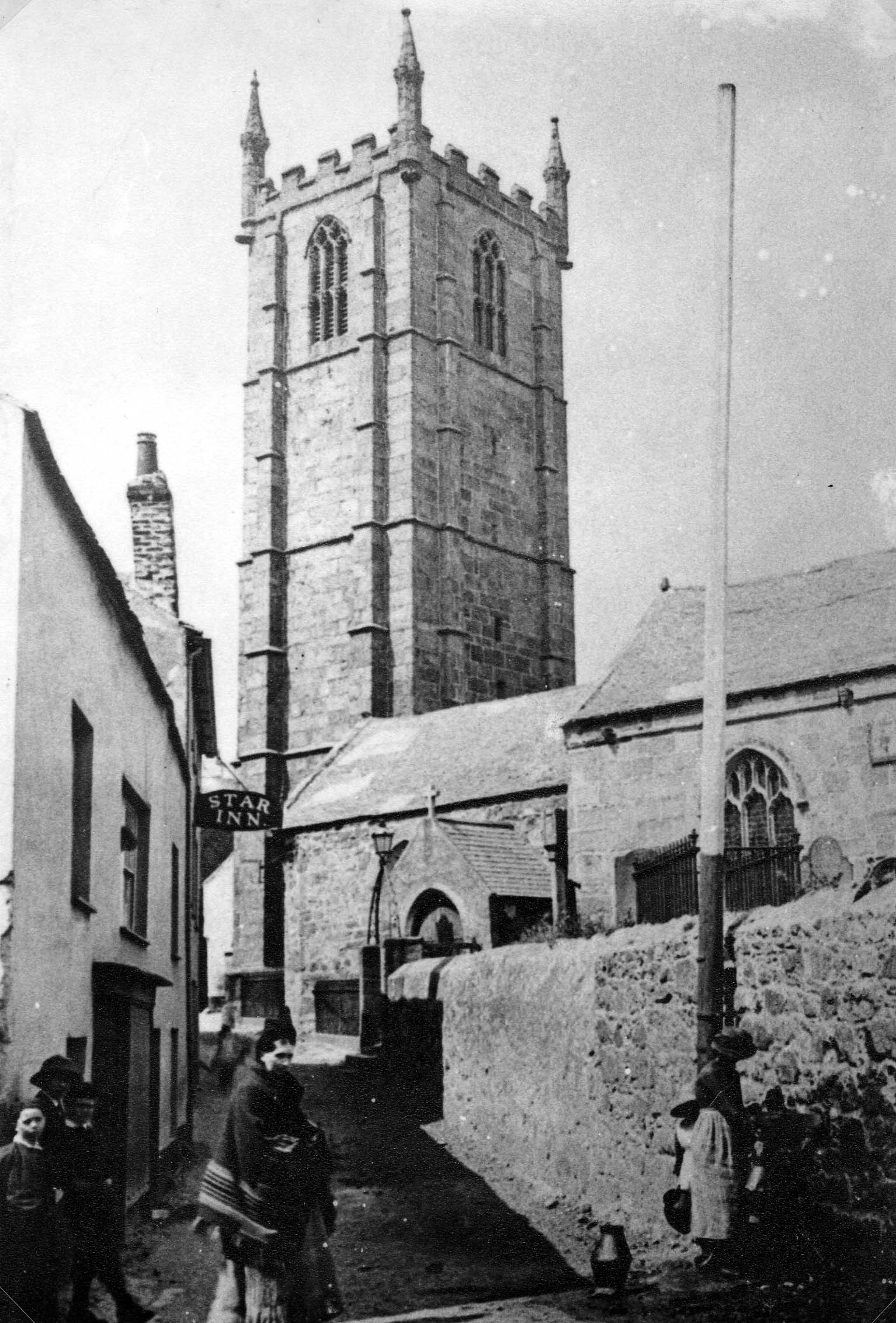
Stop 3 – St. Ives Parish Church
(stop 3 of 25)
The Parish Church of St. Ia was consecrated in 1434 and is the oldest recorded building in the town. It is built of granite from the Zennor area which was transported by sea to St. Ives. At that time the sea did not come up to the churchyard as it does now; there was a field between the church and the sea. The church's situation is unusually low for a parish church so that, despite the fact that the tower is high for Cornwall, it can be overlooked from many areas of the town. The church has many interesting features including carved pew ends. The church contains a number of works of art - in the Lady Chapel Barbara Hepworth's 'Madonna and Child' can be found.
The image shows a view of the Church from St. Andrews Street prior to the demolition of the Star Inn which can be seen on the left. The Star Inn was situated opposite the south entrance to the Church; its demolition allowed for the widening of St. Andrews Street.
On the opposite side of St. Andrews Street from the Church main entrance is the War Memorial. This is made of granite in the form of a traditional Celtic Cross. The ground on which the War Memorial is built and the adjacent Memorial Gardens was donated by Sir Edward Hain. Sir Edward Hain was the MP for St. Ives from 1900 to 1906. His manor house, Treloyhan Manor, is now a Methodist Holiday Hotel situated on Trelyon Avenue on the A3074 at the entrance to St. Ives. He and his family were great benefactors to the town; other donations are The Hain Walk, a footpath along the coast linking St. Ives and Carbis Bay, and the Edward Hain Memorial Hospital.
Stop 4 – The Market House
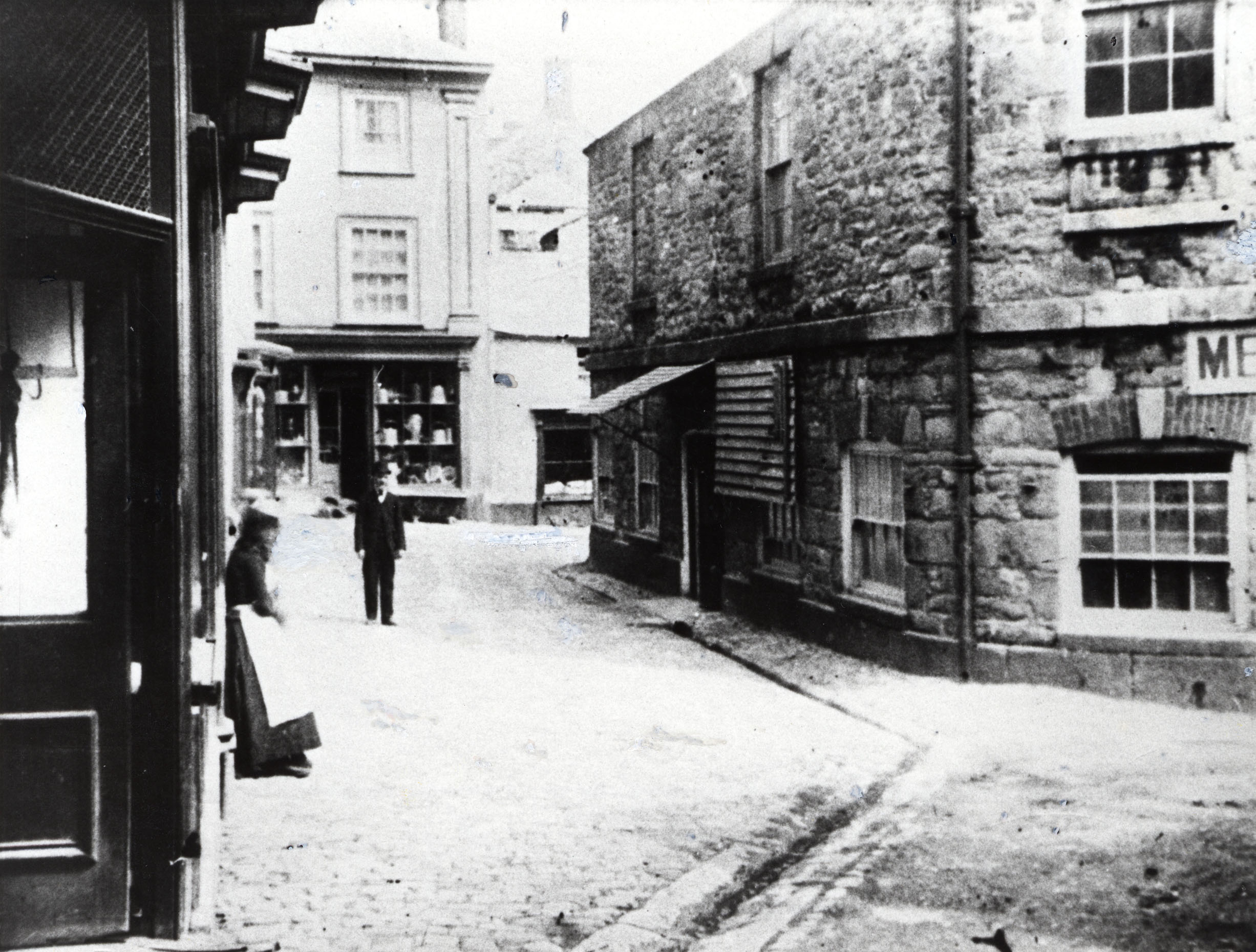
Stop 4 – The Market House
(stop 4 of 25)
In the middle of the Market Place stands the Market House which, in 1832, was built on the site of a much older one erected in 1490, chiefly by Sir Robert Willoughby, whose influence resulted in St. Ives being allowed a weekly market, held on Saturdays, and two annual fairs, on May 10th and December 3rd: The latter is called 'the Fairy Mow' (Fêr-a-moh, the pig fair) which is still celebrated. Until the Guildhall was built in 1939 the upper floor of The Market House housed the Town Council as well as providing two cells for prisoners. The Market House itself, was at the heart of the medieval town. St. Ives was granted its Borough Charter in 1639 by King Charles I. This allowed the town to have a further two fairs (July 20th and September 26th) and another market (Wednesdays). A grammar school and permission to hold magistrate's sessions every three months was also granted at this time.
In 1549, the market place was the site of the hanging of the Portreeve (Mayor) of St. Ives, John Payne who was a Catholic. In the aftermath of the Prayer Book Rebellion, the King's Commissioner and Provost Marshal came to St Ives and invited the Portreeve to dine with him. Whilst dining he requested that the Portreeve arrange for some gallows to be erected and after their meal he walked with the Portreeve to the gallows. He then asked the Portreeve to mount the gallows and ordered that he be hanged for supposedly being a "busy rebel". In 1949, a bronze and marble plaque commemorating the four-hundredth centenary of this event was put on the side of St. Ives Catholic Church.
Stop 5 – The Lifeboat-house

Stop 5 – The Lifeboat-house
(stop 5 of 25)
The lifeboat-house with the slipway in front of it were built in 1994; this allows the lifeboat to be launched faster than previously, although, at low tide, it still requires the lifeboat to be pulled on a trailer across the sand to be launched. Prior to the building of this lifeboat-house, the large building on the other side of the road, at the junction of Wharf Road and Lifeboat Hill (now the Alba Restaurant), was the lifeboat-house. At that time the lifeboat had to be pulled on a trailer along Wharf Road to the Slipway in front of the Sloop Inn to be launched or, at low tide, then pulled from the Slipway to the water's edge. In the age of mobile phones there is no longer any need for rockets to be set off to warn of the need to launch the lifeboat but in times gone by two rockets were used to summon the crew and the launching party. Not only the crew and launching party responded to the rockets but large numbers of inhabitants also used to turn out to help (see The Island – Stop 13 for their contribution on the wreck of the Alba).
The image is the Parish Church and old lifeboat-house before the West Pier was built in 1894.
Stop 6 – St. Ives Harbour
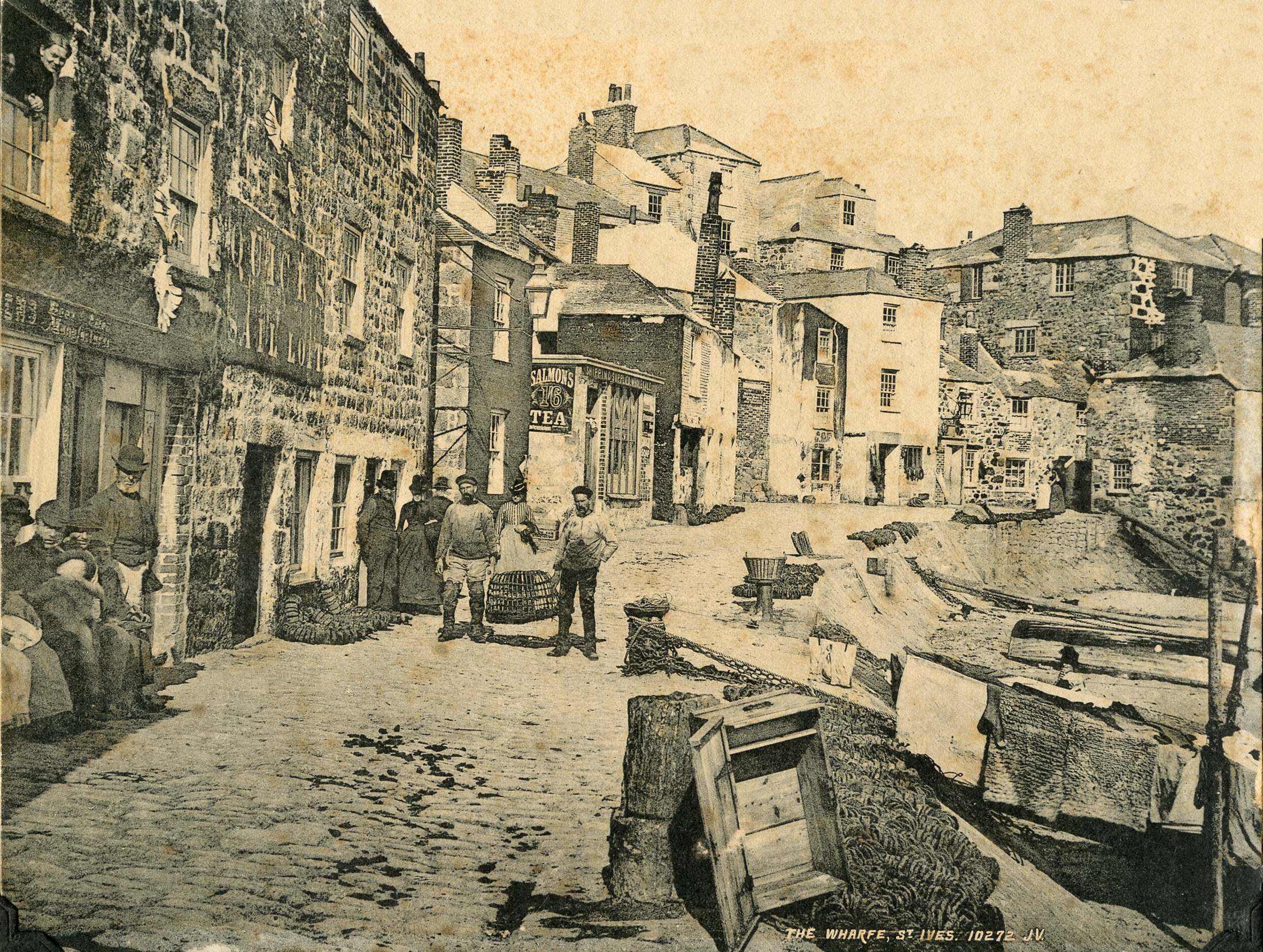
Stop 6 – St. Ives Harbour
(stop 6 of 25)
St. Ives harbour was once a bustling port. The date the first pier was constructed is not known but there was reference to it in Worcester's Itinerary in 1478. The increase in the fishing and mercantile fleets during the 18th century meant the facilities were inadequate and John Smeaton, the famous engineer, was asked to advise on what could be done. His advice resulted in the building of Smeaton's Pier. He foresaw that the harbour could be choked by sand and further advised that a wall 25-30 feet high be constructed along Porthmeor to deflect the sand. Although construction of the pier started in 1770 the wall was not built until 1801.
The building of the West Pier, adjoining the lifeboat-house and close to the church in 1894, gave the harbour the shape it has now.
The image is of the harbour when St. Ives was a very busy fishing port. On the left is Quick's Sail Loft and in one of the buildings on the right-hand side Alfred Wallis, the naïve painter, ran a marine store in the late 1800s and early 1900s..
Stop 7 – The Custom House
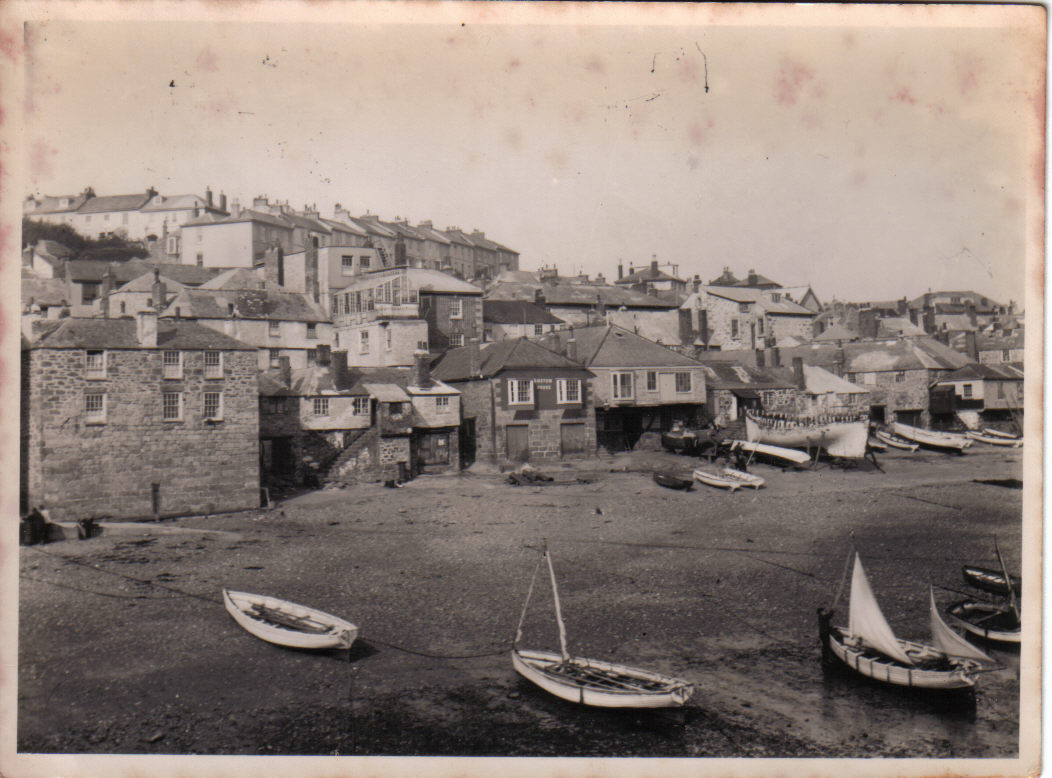
Stop 7 – The Custom House
(stop 7 of 25)
The Custom House has retained its fine frontage despite having had many uses over the years. Before the opening of the railway branch line in 1877 all goods came into and out of St. Ives by sea and the Customs Officer was one of the most important people in the town. The Wharf Road was built much later than the Custom House; previously there was a small slipway leading from the Custom House down to the shore as seen in the image.
Stop 8 – The Sloop Inn
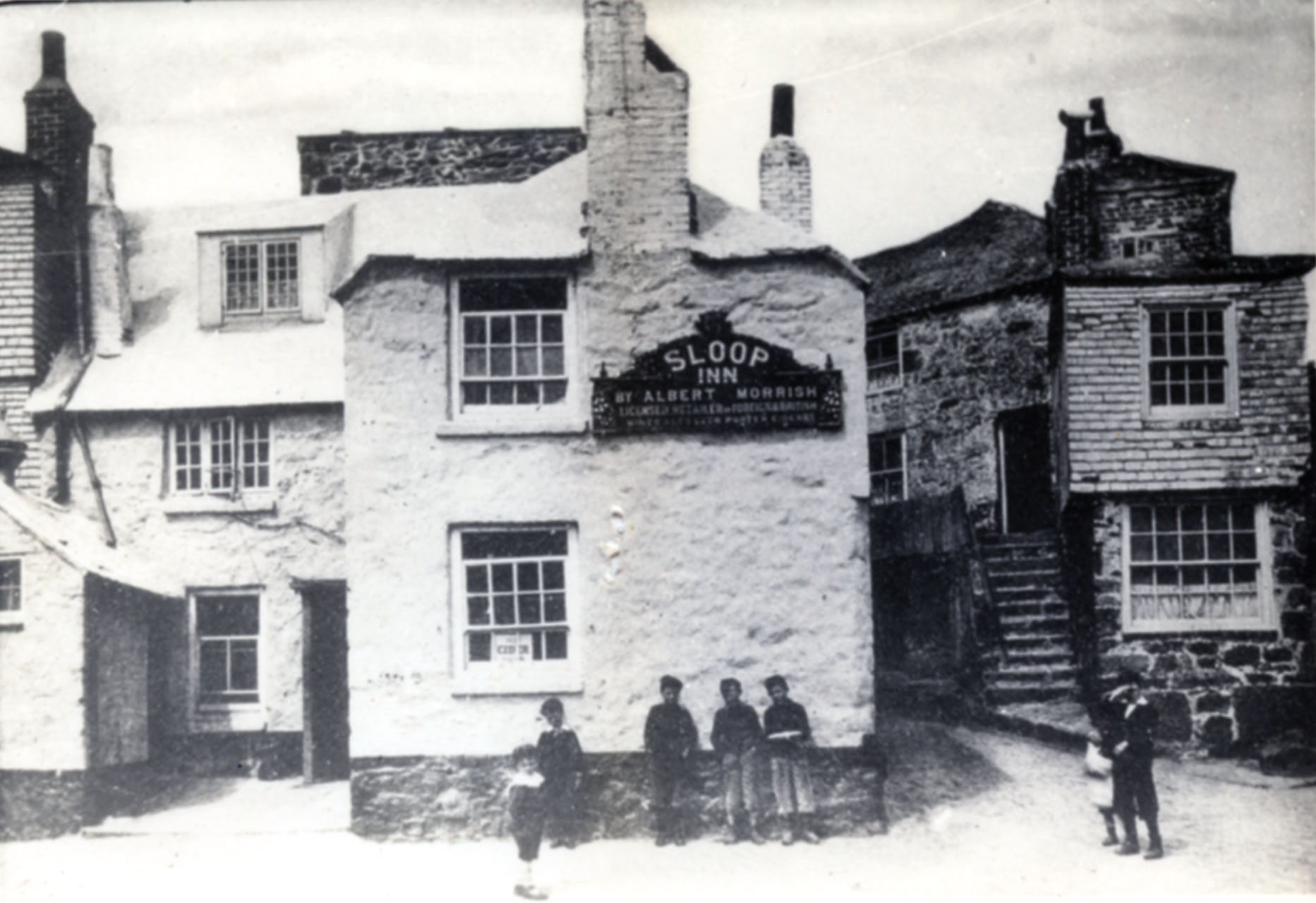
Stop 8 – The Sloop Inn
(stop 8 of 25)
The sign on the Sloop Inn shows a date earlier than the Parish Church but this has not been verified. The central location of the Sloop has ensured its importance as a meeting place used by generations of the fishing community as well as more recently by artists and visitors. At the back of the Sloop, where the Sloop car park is now, was the famous Puddingbag Lane (Put-back Lane). This was a blind alley:
'Pudding-bag Lane,
In one way, and out the same'.
The houses in Pudding Bag Lane did not have running water or sanitation and were demolished in 1936 as part of the National Slum Clearance Order. To the right of the Sloop Inn on the image can be seen the entrance to Puddingbag Lane.
Behind the Sloop Inn in a corner of the car park is the Sloop Craft Market. This was opened in 1969 on the site of a fish cellar. The features of the old cellar such as the cobbled floor and granite pillars are still much in evidence. Individual craftsmen and artists have stalls there and it is open throughout the year.
Stop 9 – Smeaton's Pier
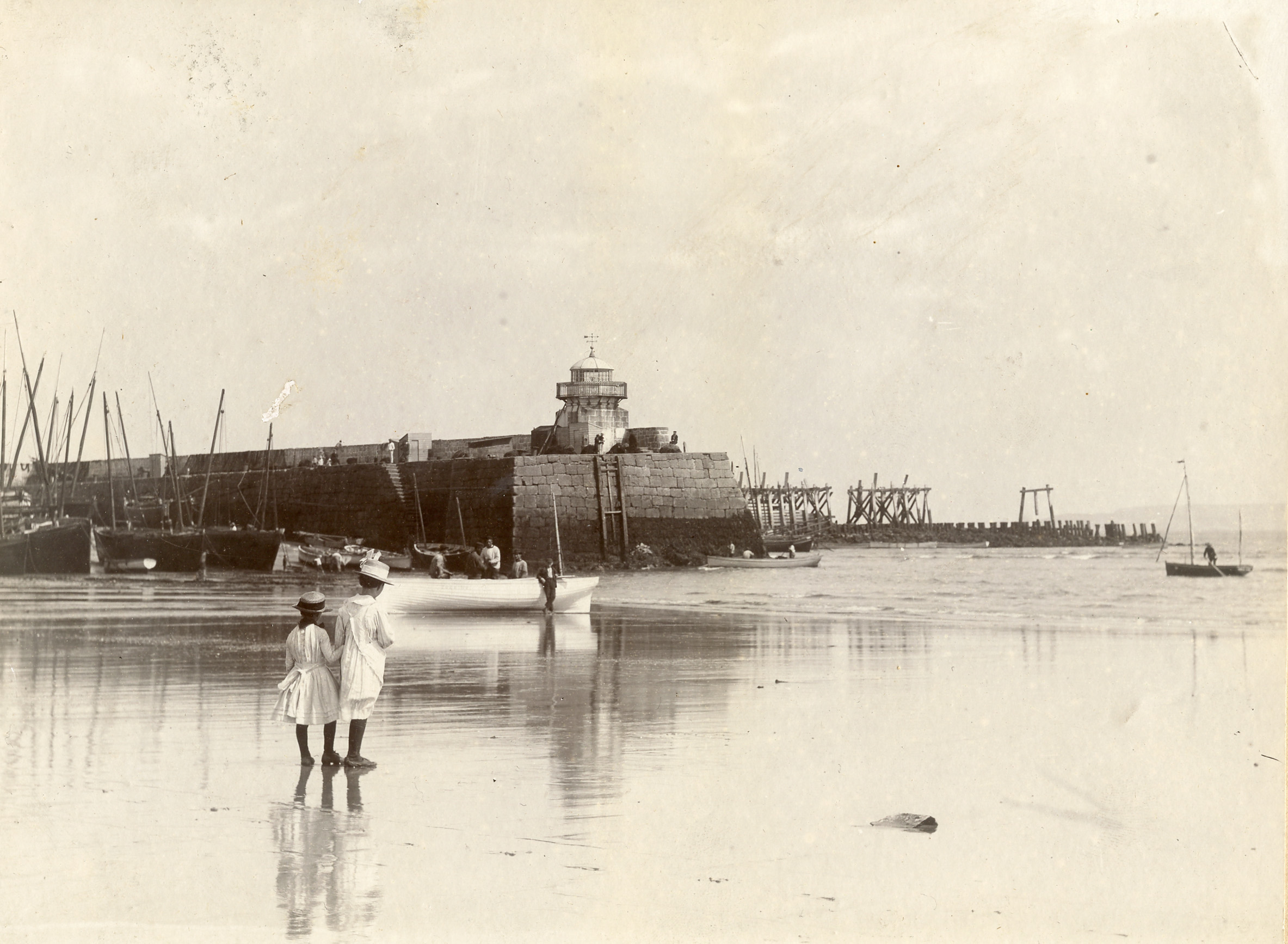
Stop 9 – Smeaton's Pier
(stop 9 of 25)
In 1770 the engineer John Smeaton, who designed the Eddystone Lighthouse, planned the first section of the granite pier that still bears his name. This pier was a vast improvement on its predecessor which sheltered a much smaller harbour. The granite used in the pier's construction was brought by boat from Zennor due to the lack of roads. The picturesque, octagonal granite lighthouse, now about half way along Smeaton's Pier, was built in 1831. Prior to this, boats were guided into the harbour by a lantern on a pole. Smeaton's Pier was lengthened in the 1880s when the Victoria Extension was constructed thereby roughly doubling the size of the harbour. The Victoria Extension has a cast-iron conventional shaped lighthouse on its end. In the 1890s the 3 arches at the landward end were blasted out of the original part of the pier. Their purpose was to allow the circulation of seawater and thus prevent the build-up of sand in the harbour.
The image is of Smeaton's Pier prior to the building of the Victoria Extension. Behind the end of Smeaton's Pier can be seen the remains of New Pier (see Stop 10).
Stop 10 – St. Leonard's Chapel
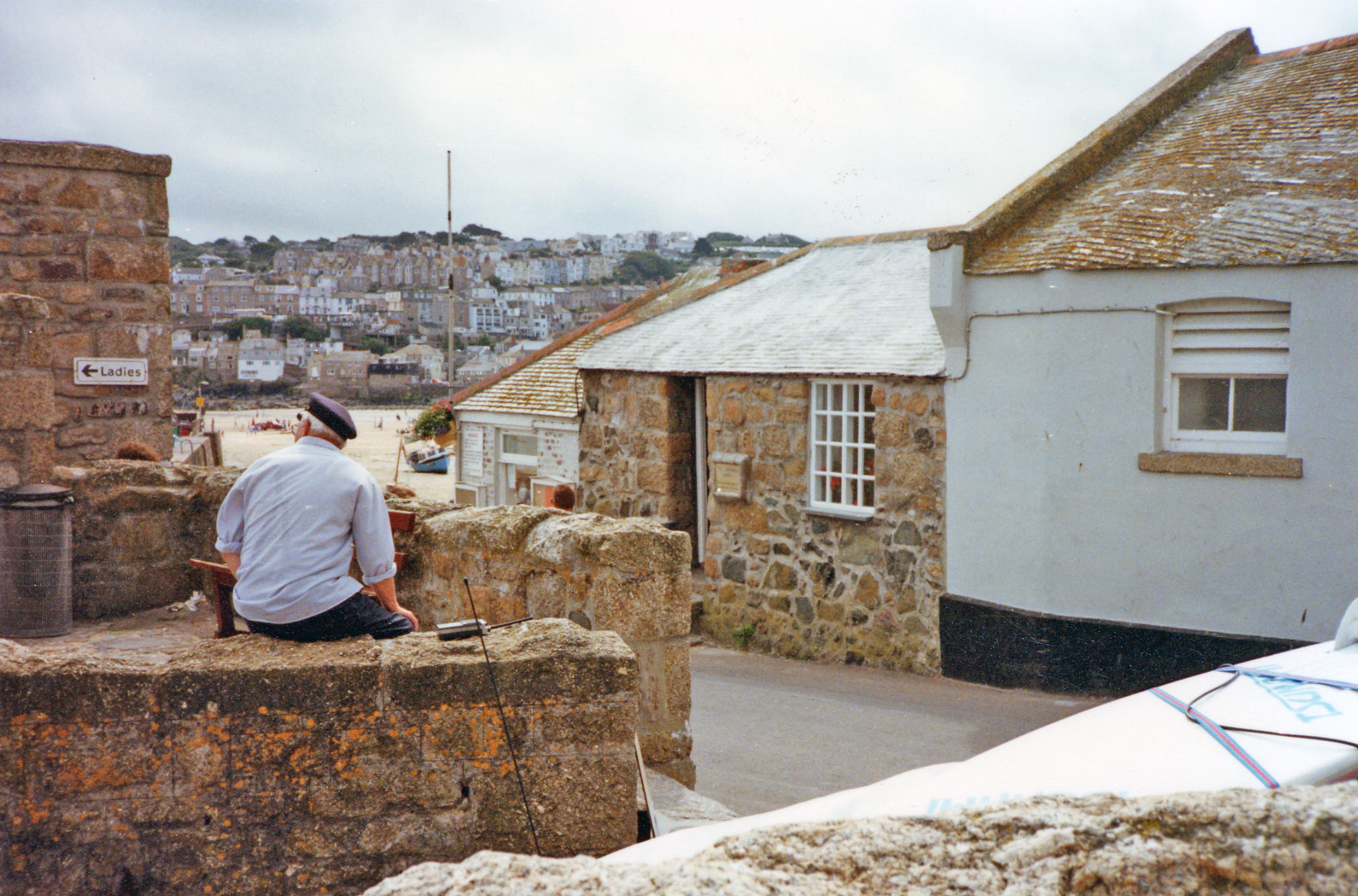
Stop 10 – St. Leonard's Chapel
(stop 10 of 25)
At the landward end of Smeaton's Pier is a tiny chapel dedicated to St. Leonard, the patron saint of fishermen. This is the traditional chapel of the fishermen of St. Ives.
It is not known when St. Leonard's was built but there are repair records going back to 1577.
If you stand close to St. Leonard's Chapel at low tide and look east the remains of the old wooden pier (called New Pier) can be seen. This was built in the 1860s because by this time with increasing trade and the thriving fishing industry the harbour had become too small. However, the New Pier's design was flawed; being for the most of its length made of a wood frame filled with loose stones. This design was nowhere near adequate to withstand north-easterly gales and it soon began to disintegrate. Today all that remains is a masonry stump and a line of stones and broken wooden stakes extending out to sea. The destruction of the New Pier led to the Victoria Extension to Smeaton's Pier.
Stop 11 – St. Ives Museum
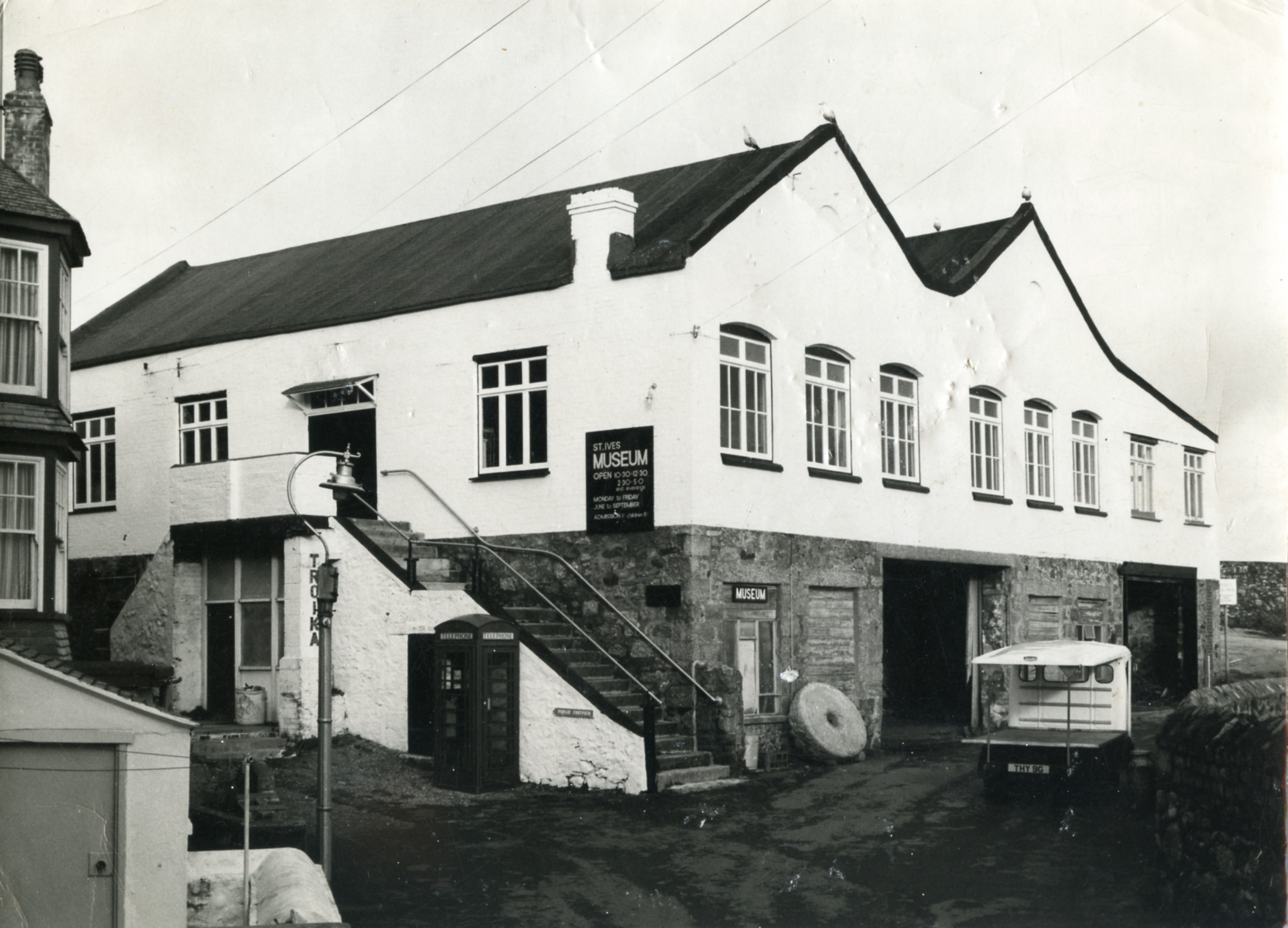
Stop 11 – St. Ives Museum
(stop 11 of 25)
St. Ives Museum is situated at Wheal Dream. ('Wheal' is the Cornish word for mine)
The Museum building was once a pilchard cellar and then a laundry. The first floor was previously the home of the Seaman's Mission.
Troika Pottery (1963-1983) was situated on the ground floor; entry to the pottery was via the door beneath the outside steps.
The Museum moved into this building in 1968 and is staffed by volunteers. It documents every aspect of the town's history. It is open from Easter to late October and is well worth a visit. A small charge is made for admission.
Stop 12 – Porthgwidden Beach
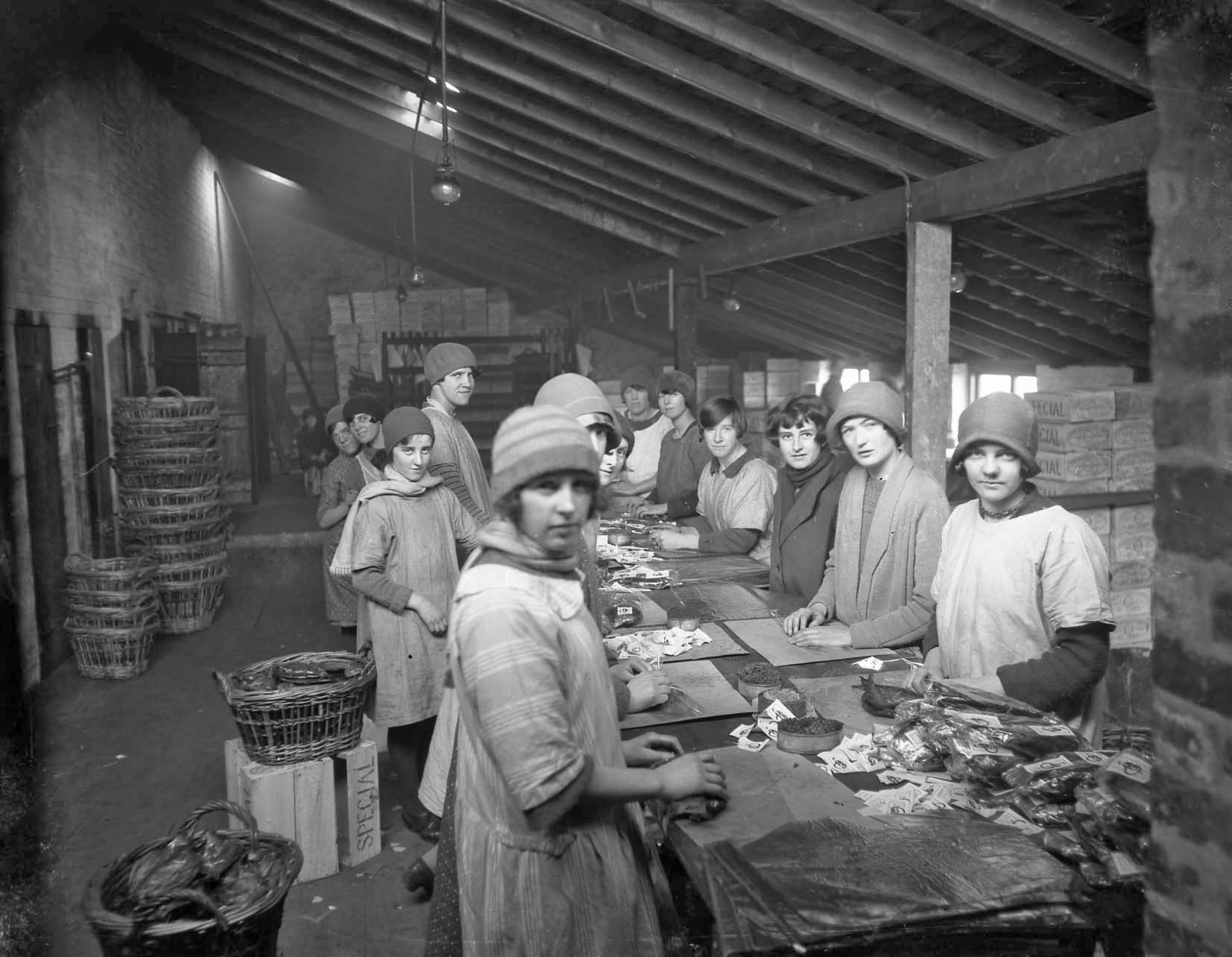
Stop 12 – Porthgwidden Beach
(stop 12 of 25)
Porthgwidden ('White Cove' in Cornish), which is the smallest of the town's four main beaches, was once the main landing place for St. Ives' fishing boats. Later it became the town's main rubbish dump; it continued to be used for dumping rubbish until the early years of the twentieth century. At the end of the nineteenth century this area became the centre for a variety of local industries including a kipper house.
The image shows 'kipper girls' working in Woodger's Kipper House.
Pigs, chickens and other small animals were also kept in the Porthgwidden area.
Stop 13 – The Island
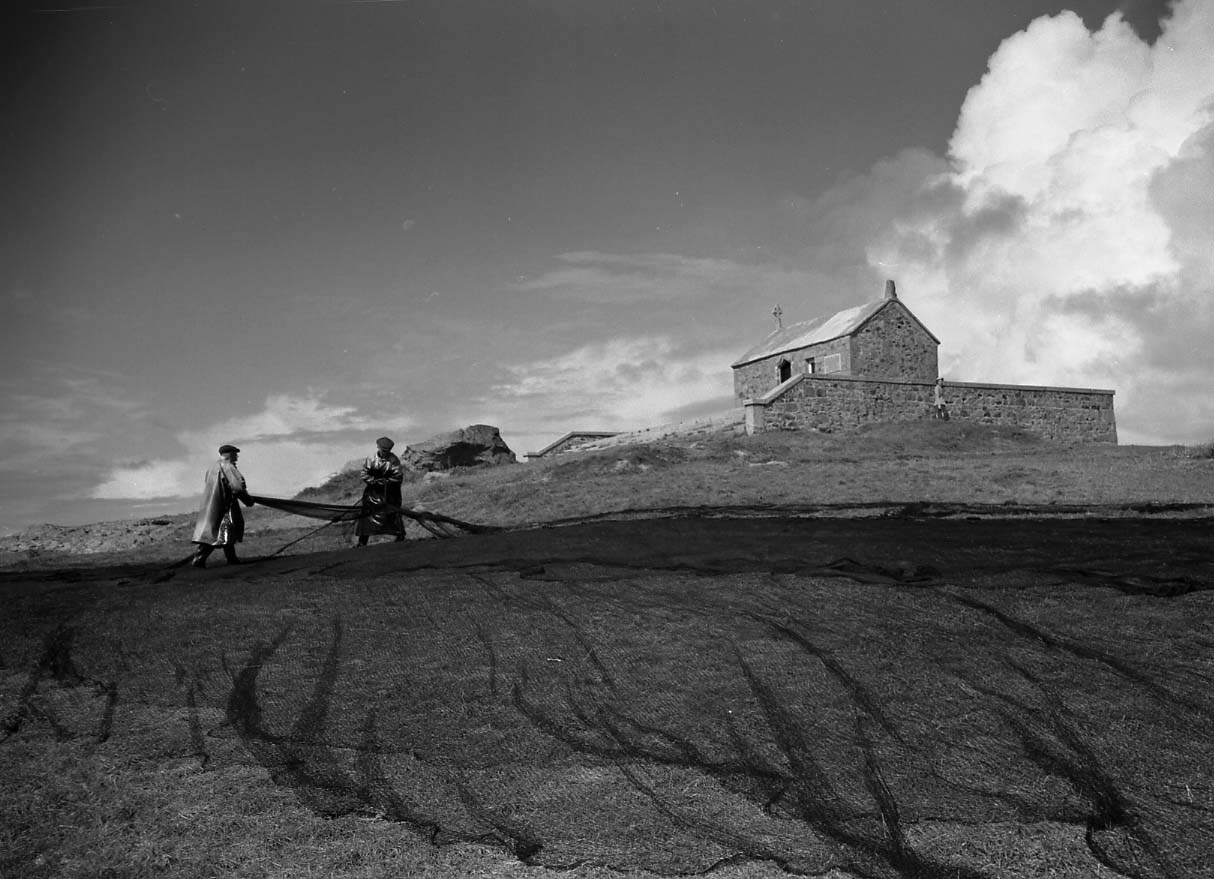
Stop 13 – The Island
(stop 13 of 25)
The older part of the town of St. Ives stands on an isthmus which separates a small peninsula from the mainland. Some centuries ago this peninsula, St. Ives Head or Pendinas Head, was entirely surrounded by water and is still known locally as 'The Island'. On the summit of The Island are two buildings and a disused granite battery which was built in 1860 in case of a French invasion. Adjoining the battery is the coastguard lookout house which was originally operated by the Coastguard but is now operated by the National Coastwatch Institution (a voluntary organisation that safeguards the lives of sea and coastal users). The coastguard house is built at Lamp Rock (deriving its name from a lamp to guide fishermen which used to stand on this site.
At the western end of The Island is St. Nicholas Chapel, one of the most iconic buildings in St. Ives. A chapel on this site probably dates from medieval times. It can be seen from many parts of the town and is dedicated to the patron saint of sailors. The original chapel was demolished by the War Office in 1904 when it was not required any more. There was such an outcry from the town that it was rebuilt by Sir Edward Hain in 1911.
The image shows fishermen laying out their nets to dry on The Island with St. Nicholas Chapel on the summit..
At the base of The Island is St. Nicholas Court, a complex of luxury apartments. This was once the home of the Great Western Cellar, the largest pilchard packing factory in the country. In 1926 it became the Crysede silk factory, making luxury hand block printed clothes. During World War 2 it made camouflage nets.
Stop 14 – Porthmeor
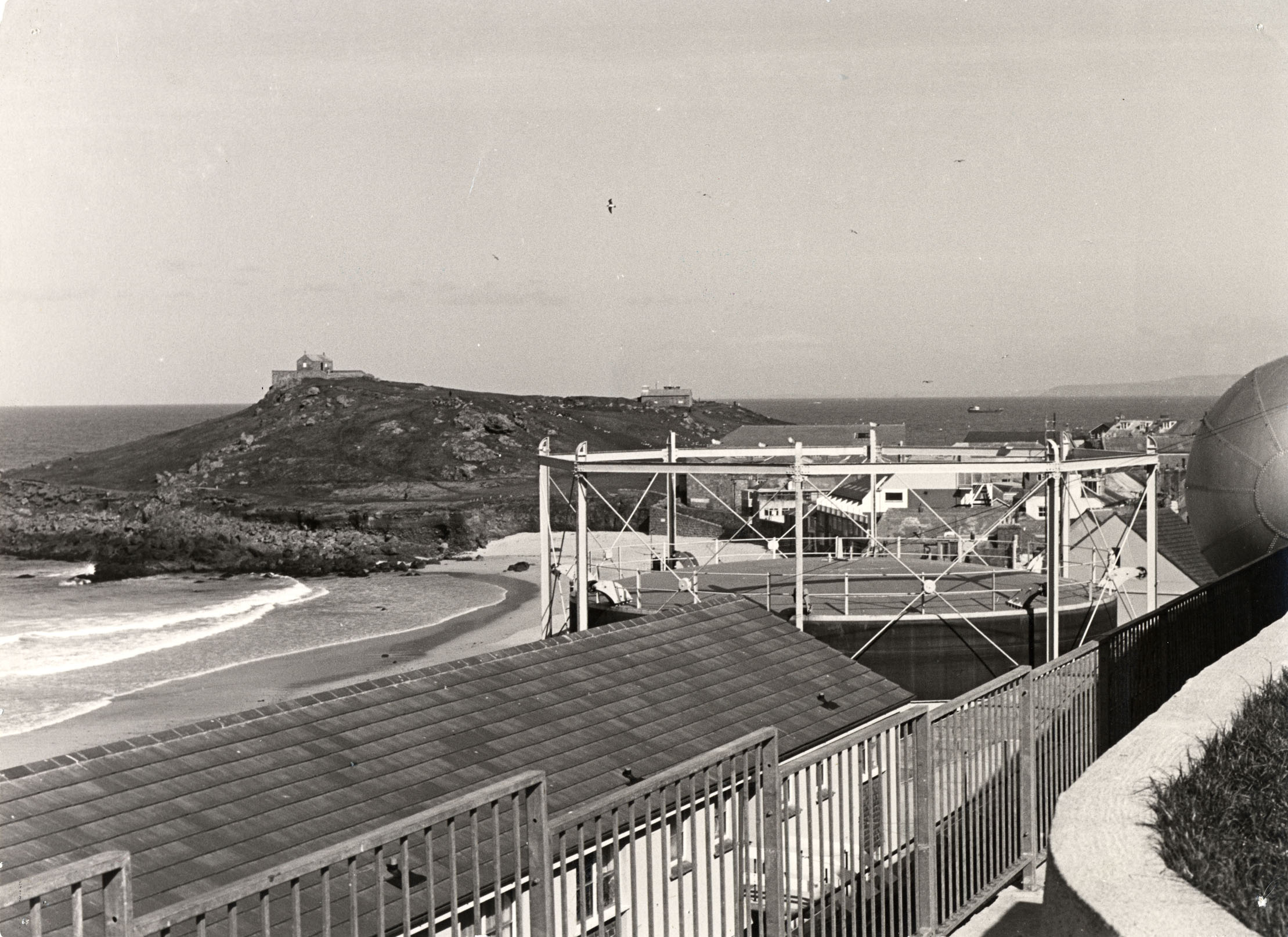
Stop 14 – Porthmeor
(stop 14 of 25)
To the north of The Island is the wide sweep of Porthmeor Beach, a favourite surfing area. Porthmeor in Cornish means the big cove. At low tide the wreck of the 'S.S.Alba' can be seen on The Island side of the beach. 'Alba' was a Panamanian coal boat which ran aground on the rocks in January 1938 during a fierce gale. On hearing the lifeboat rockets a number of townsfolk gathered on the west side of The Island. To help the rescue, cars were driven to an appropriate spot and their headlamps turned on to where the Alba lay in the surf to aid the rescue. While trying to rescue the survivors, the St. Ives lifeboat (The Caroline Parsons) was capsized by a huge wave. All the lifeboat-men and all but four of the Hungarian crew of the Alba survived.
The image is a view taken from Barnoon Cemetery looking across Porthmeor towards The Island. In the foreground, where The Tate now stands, can be seen a gasometer as this was previously the site of the town's gas works.
On the road at the western end of the Beach is 'Venton Ia' (St. Ia's Well), which is reputed to have been the water supply for the original settlement of St. Ives.
Stop 15 – Tate St. Ives
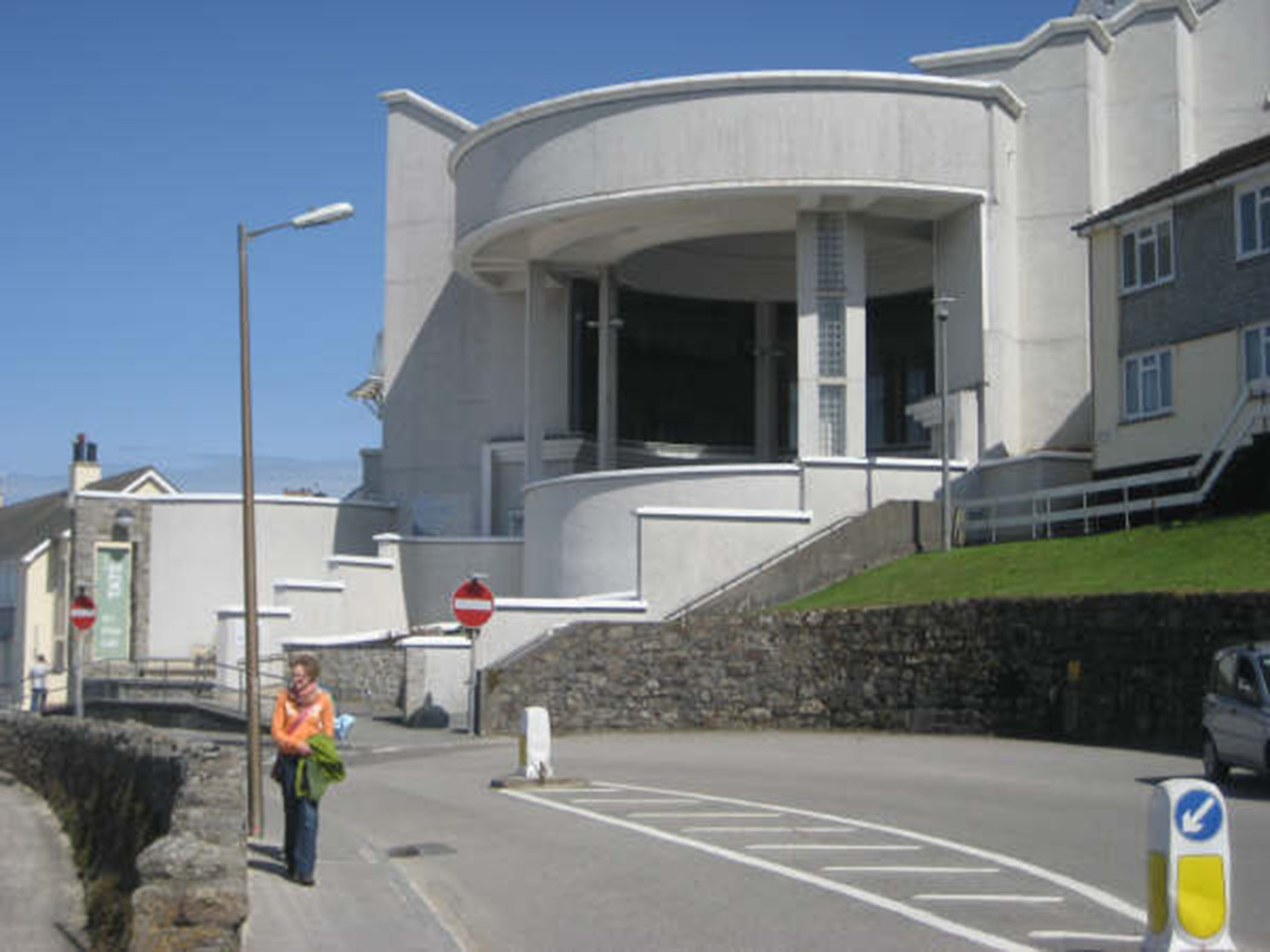
Stop 15 – Tate St. Ives
(stop 15 of 25)
Tate St. Ives was opened in 1993 to show the St. Ives modernist paintings and sculpture owned by the Tate. It was built on the site of the town's gas works which had been bombed in World War 2 and was finally dismantled in 1985. Tate St. Ives was designed by Evans and Shalev, the gallery was instrumental in promoting cultural tourism in St. Ives.
An extension to the Tate is currently under construction and is due to be completed in 2016. It will include a small permanent collection.
Stop 16 - Back Road West

Stop 16 - Back Road West
(stop 16 of 25)
Situated on Back Road West and backing onto Porthmeor Beach is Porthmeor Studios. It was constructed in the mid 1880s for the pilchard fishing industry. When fishing declined at the end of that century the artists began to move in and the building was enlarged to accommodate them. Now the last original building along Porthmeor Beach, it has recently been renovated thanks to funding from a number of public bodies.
Further along the street a slate tablet commemorating the home of the primitive artist and mariner Alfred Wallis can be found on the wall of 3, Back Road West. Wallis started painting when he was seventy on bits of wood and cardboard using house and ship paint. He was 'discovered' by the artists Ben Nicholson and Christopher Wood in 1928. His naïve images of the sea and the town inspired a new generation of modernist painters. He died at Madron Workhouse in 1942 and his grave stone at Barnoon Cemetery (behind Tate St. Ives, Stop 15)) is made of Leach tiles depicting a lighthouse that was designed by Bernard Leach (Stop 25).
Stop 17 - The Digey

Stop 17 - The Digey
(stop 17 of 25)
Halfway along and off to the side of The Digey, formed by three granite slabs, stands the Old Arch. This previously led to a courtyard in front of Hick's Court, a large house belonging to George Hicks who was Portreeve of St. Ives (Mayor prior to St. Ives being made a municipality in 1639) in the early 1600s. A plaque commemorates this fact. In the 19th century this was a location of a bake-house, where local women would bring their dough to be baked. The Arch Pottery was also located here (1955-1966).
A bake-house from the 19th century still stands in Back Road East near its junction with Fish Street.
Stop 18 - Barbara Hepworth Museum & Sculpture Garden

Stop 18 - Barbara Hepworth Museum & Sculpture Garden
(stop 18 of 25)
The Barbara Hepworth Museum was the home of Dame Barbara Hepworth from 1949 until her death in a fire in 1975. She requested that, following her death, both her home and garden should be permanently open to the public. It was taken over by the Tate in 1980 and is a quiet haven in the midst of the town. Around the town, public pieces of Hepworth Sculpture can be seen at The Malakoff (Stop 23), outside The Guildhall (Stop 2), on the ground floor of St Ives Library (Stop 19), in the Lady Chapel of St. Ives Parish Church and inside the main gate at Longstone Cemetery in Carbis Bay. In London, 'Winged Figure' can be seen on the John Lewis building in Oxford Street.
The image shows Dame Barbara Hepworth with one of her sculptures.
Stop 19 – St. Ives Library
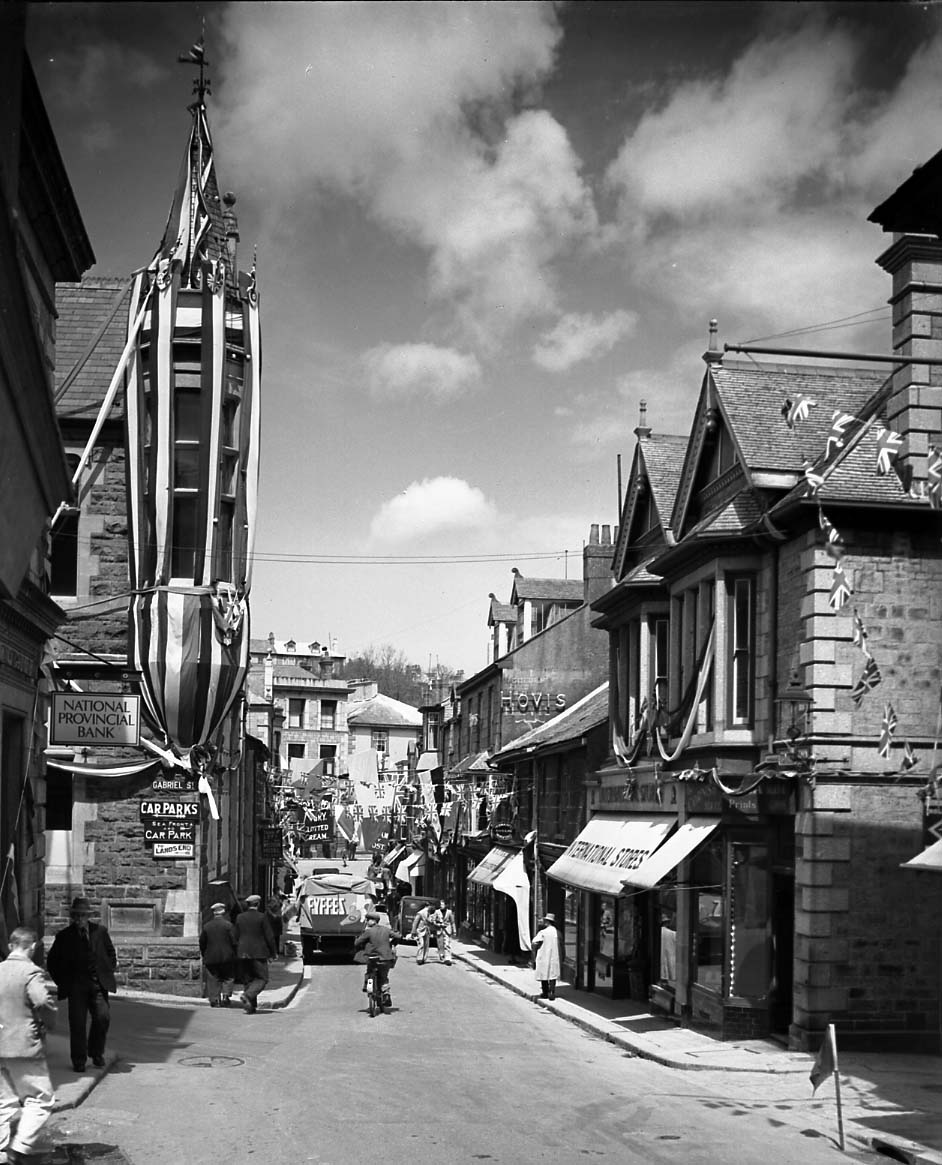
Stop 19 – St. Ives Library
(stop 19 of 25)
St. Ives Library stands on the corner of Tregenna Place and Gabriel Street. The building was financed by the Cornish philanthropist John Passmore Edwards who wanted to bring learning and culture to the 'working man'. It was opened in 1896 and has been at the heart of the local community ever since. It was modernised and extended in 2004.
Opposite the library on the corner of Tregenna Place and Street-an-Pol (street by the pool) is a Weatherspoon pub called the 'Hain Line.' The 'Hain Line' refers to the Hain Steamship Company which operated from St. Ives in the late 1800's and early 1900's. The pub is located in the sometime office of the Company.
In the image International Stores is in the premises that is now occupied by the Hain Line.
Stop 20 – St. Ives Archive
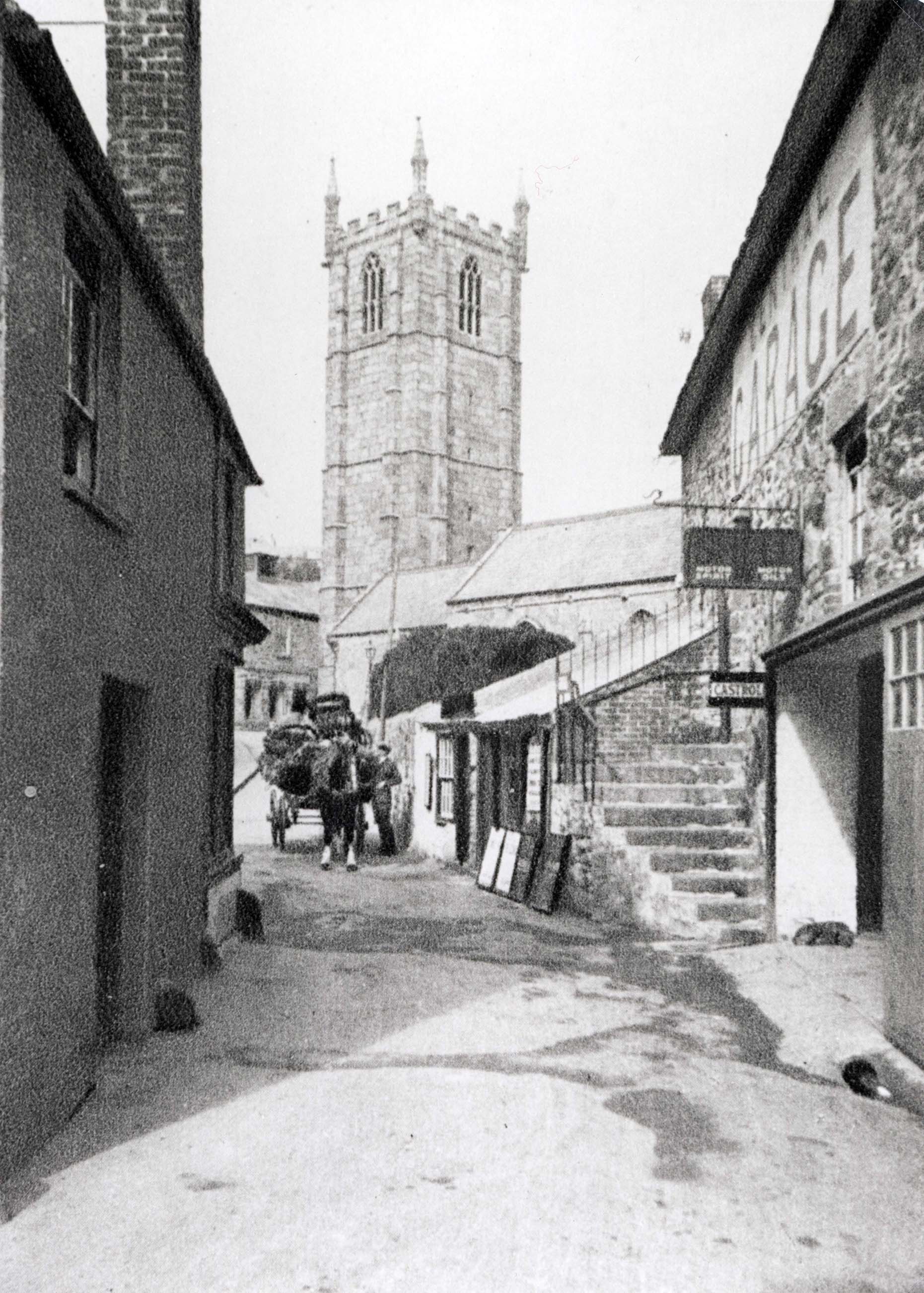
Stop 20 – St. Ives Archive
(stop 20 of 25)
St. Ives Archive is situated on the first floor of the Parish Rooms, off St. Andrews Street. It opened in 1996 and collects information about St. Ives and its history as well as the surrounding areas of Lelant, Carbis Bay and Halsetown. It holds a large collection of photographs. It is open to the public from 10am to 4pm in the summer and 10am to 2pm in the winter. Entrance is free.
The image is a picture of St. Andrews Street looking towards the church taken in the early 1900s with the Central Garage (now Chy-an-Eglos apartments) on the right.
Stop 21 – Pedn Olva
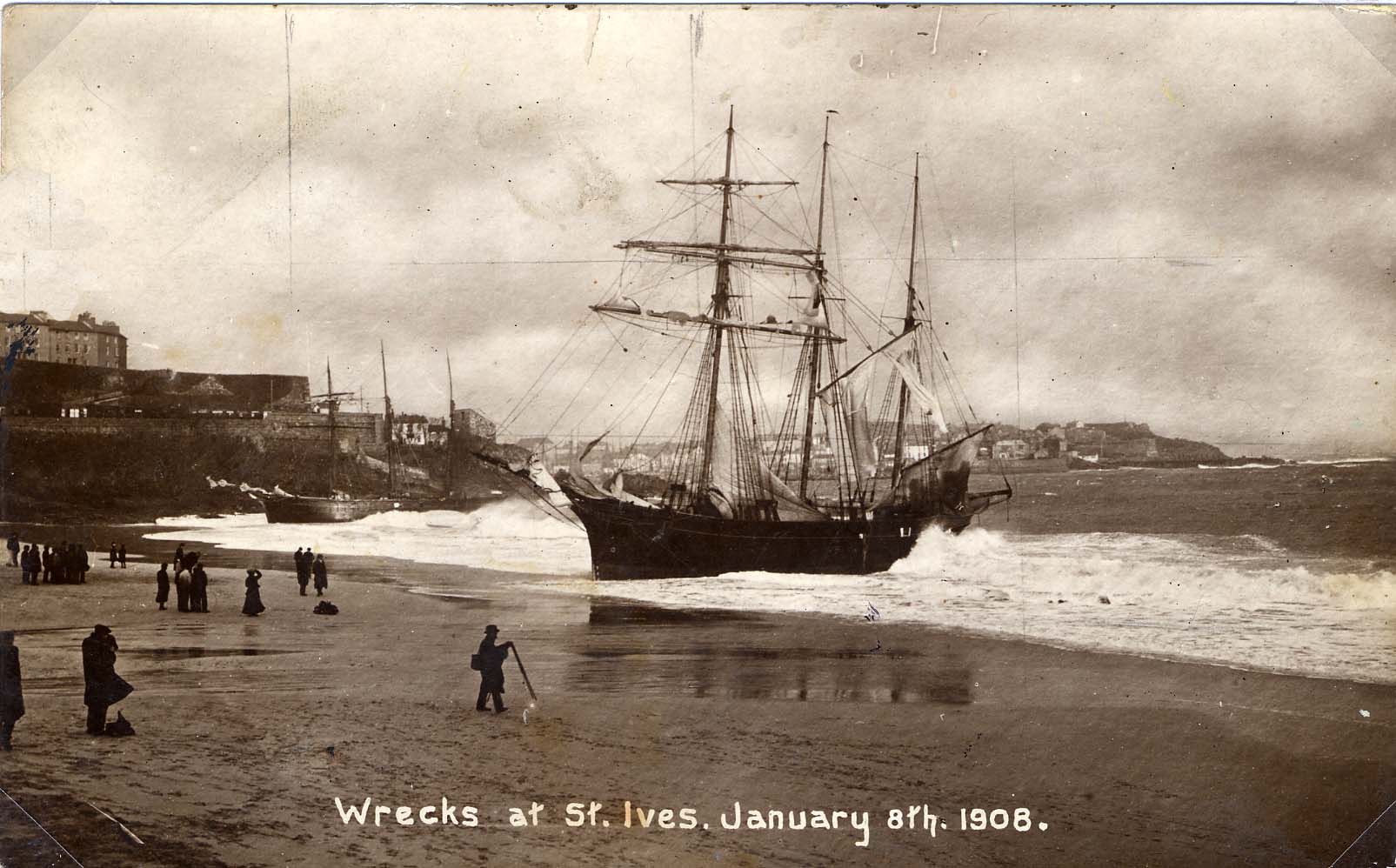
Stop 21 – Pedn Olva
(stop 21 of 25)
Between the harbour and Porthminster Beach, is a rocky outcrop (Pedn Olva Point) on which Pedn Olva Hotel now stands.
In the 1800s the engine house of a mine stood here. At that time St. Ives, like other parts of Cornwall, was an important tin and copper mining area. This particular mine was a failure as it was believed to be unsafe. The engine house became an artist's studio before the hotel was built. A World War 2 pillbox, well camouflaged as it is made of local rock, stands below the hotel.
The image shows the engine house of the mine on Pedn Olva Point behind wrecks on Porthminster Beach following a storm in January 1908.
Stop 22 – Porthminster
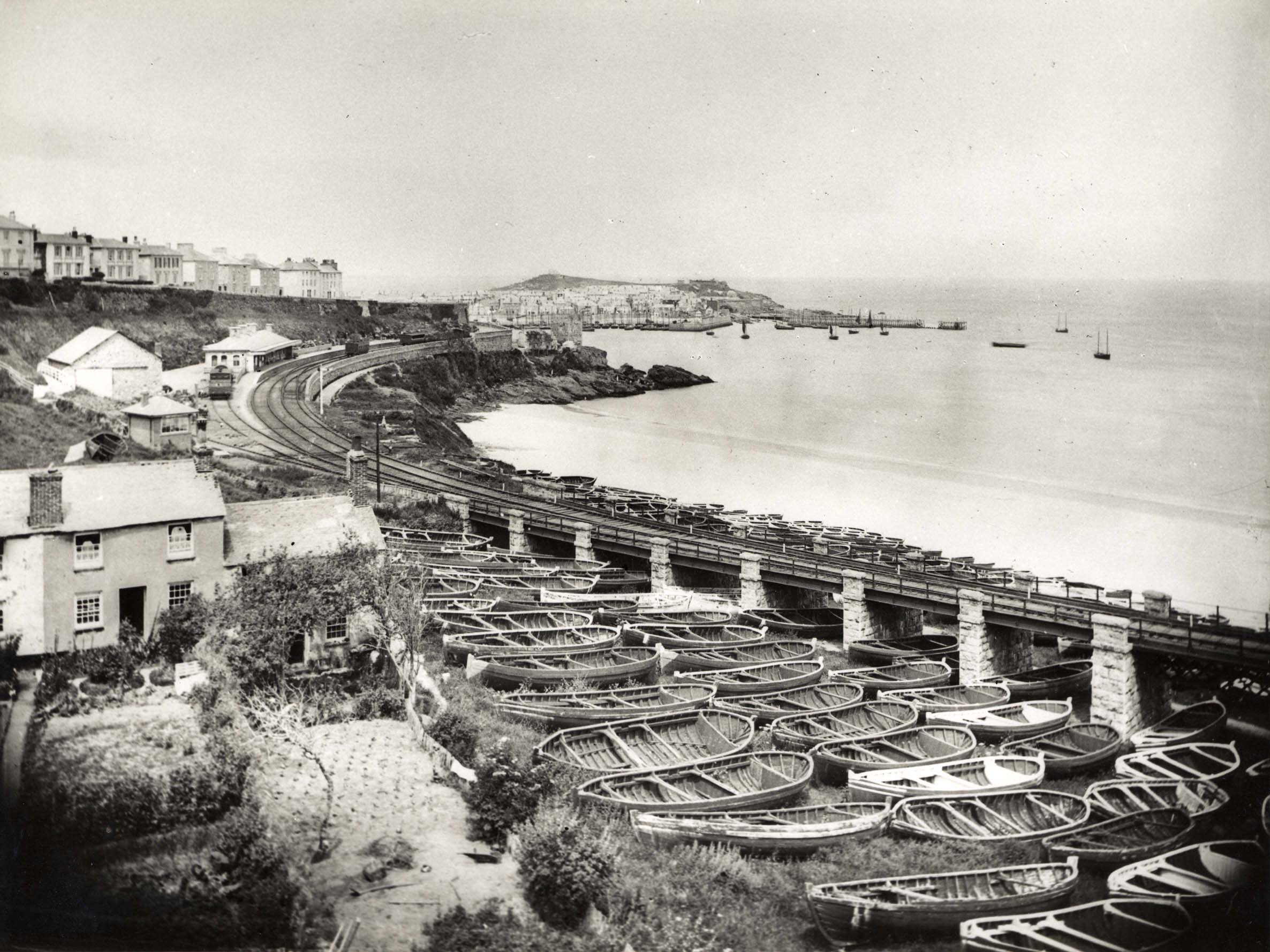
Stop 22 – Porthminster
(stop 22 of 25)
To the south-east of the old town of St. Ives, nestling between Pedn Olva Point and Porthminster Point, is the sandy cove of Porthminster. 'Minster' in the name refers to a church that long ago stood in the valley behind the beach. Porthminster Beach is a popular, safe, family beach today being more sheltered than the larger but more exposed Porthmeor Beach.
Originally, however, the beach and the area up to the railway arches were used for storing the seine boats for pilchard fishing. Seining required great organisation. When a shoal of pilchards was spotted from the Huer's Hut, high up on Porthminster Point and today located on Hain Walk, the Huer would shout “Hevva” through a long speaking trumpet to alert the seine fisherman of the shoal. Then by means of semaphore signals they would direct the boats where to shoot their nets to maximise the catch. Around the year 1900 an estimated catch of 13 million pilchards was landed in St. Ives harbour in one day. The seine fishery died out around 1920.
The Porthminster area was well known for its entertainments and cafes in the early part of the 20th century and the two Art Deco buildings at the two main entrances to the beach attest to this.
The image shows Porthminster at the height of the seine fishing industry with a large number of seine boats on the beach and pulled up onto the shore beyond the railway viaduct.
Stop 23 – The Terrace and Malakoff

Stop 23 – The Terrace and Malakoff
(stop 23 of 25)
The buildings on The Terrace, overlooking the harbour and bay, were the first homes built around 1820 for the town's gentry, high above the fishing smells. Originally a private road, it later became the main entrance to the town as part of the A3074. On the seaward side of The Terrace near the town end where the road bends is 'The Malakoff' which was constructed around the time of the Crimean War. The name refers to the Fortress and Battle of Malakoff in the Crimean War.
From The Malakoff looking across St. Ives Bay, Godrevy Lighthouse can be seen. This was built on Godrevy Island in the 1850s after a number of ships, the last of which was the screw steamer 'Nile,' had been wrecked in the preceding years. The millstone from the Nile is now embedded in the road outside the Lifeboat-house shop (Stop 5). Although the lighthouse is situated on Godrevy Island, its purpose is to warn ships of the dangers of 'The Stones', a long line of jagged rocks that protrude under the surface of the sea off Godrevy. The tops of the rocks can be seen as waves break over them at low tide.
The image, taken soon after the coming of the railway to St. Ives, is looking down The Terrace towards The Malakoff. The Terrace (now the entrance to St. Ives on the A3074) was at the time a gated private road and the main entrance to St. Ives was along the back of The Terrace houses.
The engine house of the mine on Pedn Olva Point (Stop 21) can be seen clearly.
Stop 24 – Knill's Monument, The Steeple
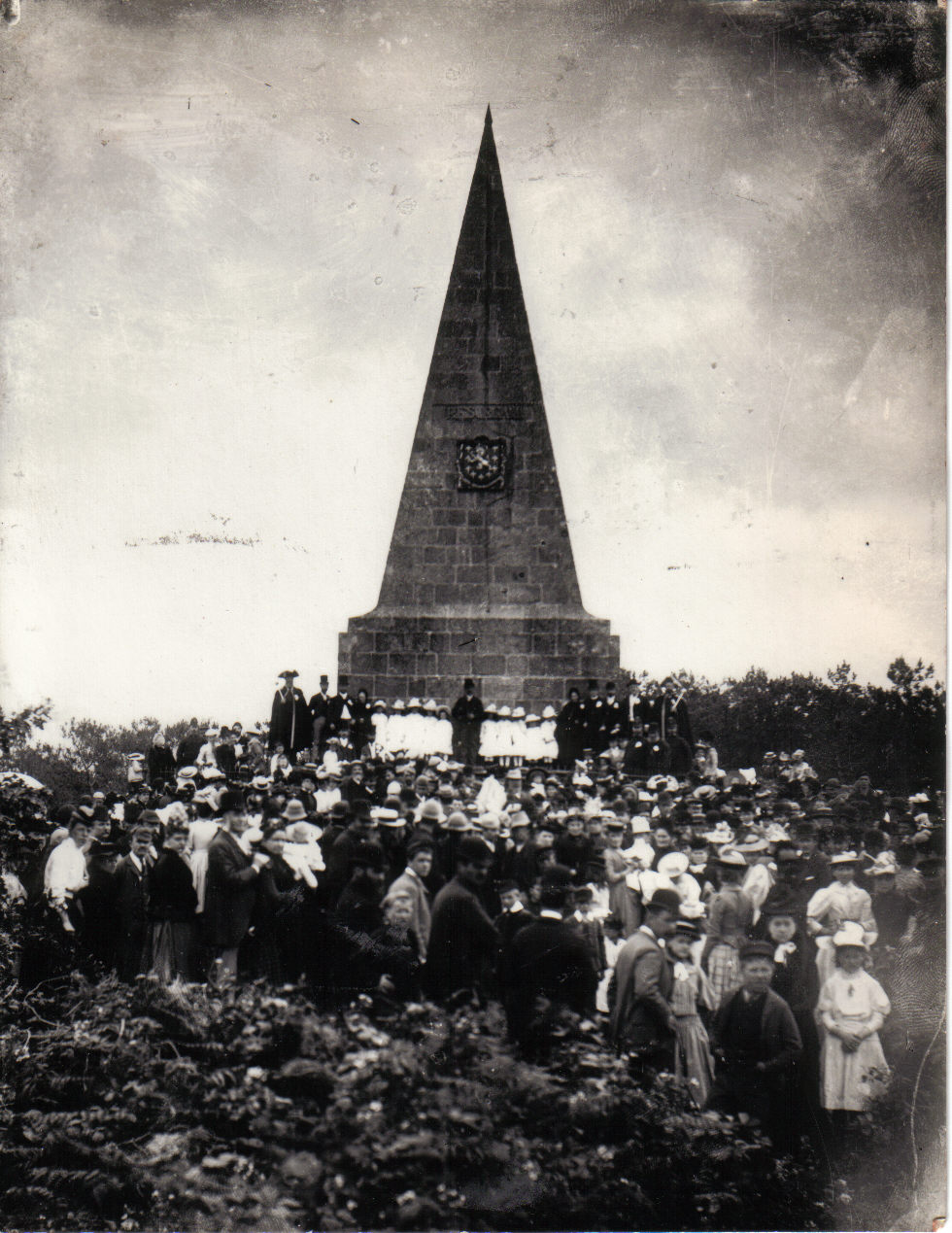
Stop 24 – Knill's Monument, The Steeple
(stop 24 of 25)
In 1782 John Knill erected on Worvas Hill, to the south of the town, a 50 foot high granite obelisk as his mausoleum. This is visible on the skyline above St. Ives from many places in the town and surrounding countryside. Knill's Monument is referred to locally as 'The Steeple'.
Although not a native of St. Ives Knill developed a great affection for the town which he served in various guises; Customs Officer, Mayor and MP.
In his will he said “It is natural to love those whom you have had opportunities of serving, and I confess I have real affection for St Ives and its inhabitants, in whose memory I have an ardent desire to continue a little longer than the usual time those do of whom there is no ostensible memorial. To that end my vanity prompted me to erect a mausoleum and to institute certain periodical returns of a ceremony ...”. He left an annuity to the Borough of St. Ives for the upkeep of the mausoleum and for the establishment of a ceremony to be held once every five years on St. James' Day (25th July). In the first ceremony in 1801, Knill himself took part. Knill died in London in 1811 and was buried in Holborn so the vault is empty but the ceremony continues every five years.
The next ceremony is due on 25th July 2016.
The image was taken at Knill's Steeple at the time of a Knill ceremony in the early 20th century
Stop 25 – Leach Pottery
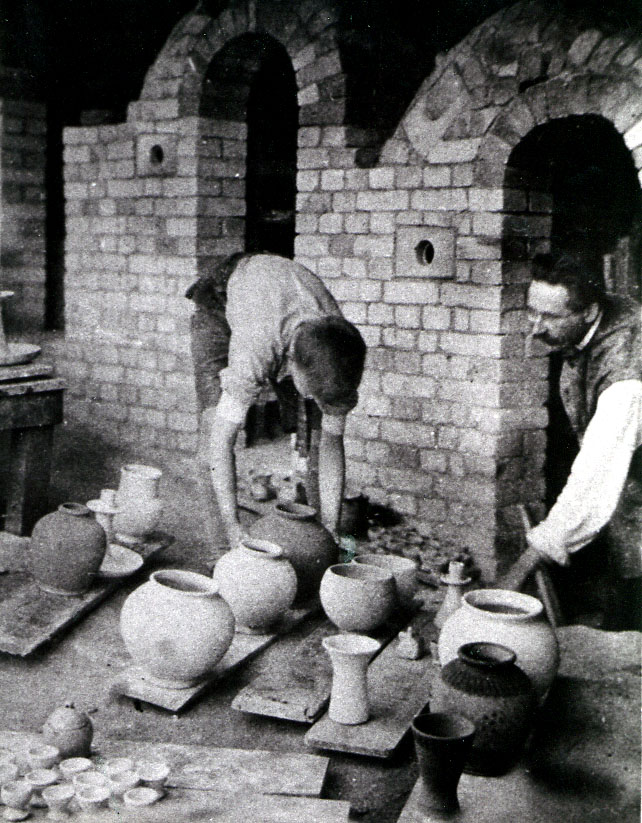
Stop 25 – Leach Pottery
(stop 25 of 25)
Bernard Leach and Shoji Hamada founded a pottery next to the Stennack River (Stennack is Cornish for the tin-bearing place) in 1920. In 1909, after studying at the Slade School of Fine Art and the London School of Art, he went to Japan where he first became interested in ceramics. Leach and Shoji built a traditional Japanese climbing kiln which was the first such kiln in the West. Leach promoted simple, utilitarian forms in contrast to what he called 'fine art pots' which made function subservient to aesthetics. Potters, students and apprentices from many countries have come to the Leach Pottery to train, and have maintained the pottery's creative principle of East/West exchange.
The Leach Pottery is among the most respected and influential studio potteries in the world. The recently renovated pottery, museum and gallery continue Bernard Leach's legacy.
The image shows Bernard Leach loading the kiln.


My St Ives Archive Notes

St Ives Archive
St. Ives Archive Centre was set up in 1996. It is based in the Upper Parish Rooms. It is open from 10 am to 4 pm (except January and February 10am to 2pm).
- Introduction
- These terms and conditions govern your use of our website.
- By using our website, you accept these terms and conditions in full; accordingly, if you disagree with these terms and conditions or any part of these terms and conditions, you must not use our website.
- If you submit any material to our website or use any of our website services, we will ask you to expressly agree to these terms and conditions.
- You must be at least 13 years of age to use our website; and by using our website or agreeing to these terms and conditions, you warrant and represent to us that you are at least 13 years of age.
- Our website uses cookies; by using our website or agreeing to these terms and conditions, you consent to our use of cookies.
- Copyright notice
- Copyright (c) 2024 St Ives Archive.
- Subject to the express provisions of these terms and conditions:
(a)we, together with our licensors, own and control all the copyright and other intellectual property rights in our website and the material on our website; and
(b)all the copyright and other intellectual property rights in our website and the material on our website are reserved.
- Licence to use website
- You may:
(a)view pages from our website in a web browser;
(b)download pages from our website for caching in a web browser;
(c)print pages from our website;
(d)stream audio and video files from our website; and
(e)use our website services by means of a web browser,
subject to the other provisions of these terms and conditions. - Except as expressly permitted by the other provisions of these terms and conditions, you must not download any material from our website or save any such material to your computer.
- You may only use our website for your own personal and business purposes and you must not use our website for any other purposes.
- Except as expressly permitted by these terms and conditions, you must not edit or otherwise modify any material on our website.
- Unless you own or control the relevant rights in the material, you must not:
(a)republish material from our website (including republication on another website);
(b)sell, rent or sub-license material from our website;
(c)show any material from our website in public;
(d)exploit material from our website for a commercial purpose; or
(e)redistribute material from our website. - We reserve the right to restrict access to areas of our website, or indeed our whole website, at our discretion; you must not circumvent or bypass, or attempt to circumvent or bypass, any access restriction measures on our website.
- You may:
- Acceptable use
- You must not:
(a)use our website in any way or take any action that causes, or may cause, damage to the website or impairment of the performance, availability or accessibility of the website;
(b)use our website in any way that is unlawful, illegal, fraudulent or harmful, or in connection with any unlawful, illegal, fraudulent or harmful purpose or activity;
(c)use our website to copy, store, host, transmit, send, use, publish or distribute any material which consists of (or is linked to) any spyware, computer virus, Trojan horse, worm, keystroke logger, rootkit or other malicious computer software;
(d)conduct any systematic or automated data collection activities (including without limitation scraping, data mining, data extraction and data harvesting) on or in relation to our website without our express written consent;
(e)access or otherwise interact with our website using any robot, spider or other automated means;
(f)violate the directives set out in the robots.txt file for our website; or
(g)use data collected from our website for any direct marketing activity (including without limitation email marketing, SMS marketing, telemarketing and direct mailing). - You must not use data collected from our website to contact individuals, companies or other persons or entities.
- You must ensure that all the information you supply to us through our website, or in relation to our website, is true, accurate, current, complete and non-misleading.
- You must not:
- Posting material
- To be eligible to post information on our website you must be at least 13 years of age and resident in the United Kingdom.
- User IDs and passwords
- If you register for an account with our website, we will provide you with a user ID and password.
- Your user ID must not be liable to mislead and must comply with the content rules set out in Section 9; you must not use your account or user ID for or in connection with the impersonation of any person.
- You must keep your password confidential.
- You must notify us in writing immediately if you become aware of any disclosure of your password.
- You are responsible for any activity on our website arising out of any failure to keep your password confidential, and may be held liable for any losses arising out of such a failure.
- Cancellation and suspension of account
- We may:
(a)suspend your account;
(b)cancel your account; and/or
(c)edit your account details,
at any time in our sole discretion without notice or explanation.
- We may:
- Your content: licence
- In these terms and conditions, "your content" means all works and materials (including without limitation text, graphics, images, audio material, video material, audio-visual material, scripts, software and files) that you submit to us or our website for storage or publication on, processing by, or transmission via, our website.
- You grant to us a perpetual, irrevocable, worldwide, royalty-free, and non-exclusive license to use, reproduce, store, adapt, publish, translate and distribute your content in any existing or future media / reproduce, store and publish your content on and in relation to this website and any successor website / reproduce, store and, with your specific consent, publish your content on and in relation to this website.
- You hereby waive all your moral rights in your content to the maximum extent permitted by applicable law; and you warrant and represent that all other moral rights in your content have been waived to the maximum extent permitted by applicable law.
- Without prejudice to our other rights under these terms and conditions, if you breach any provision of these terms and conditions in any way, or if we reasonably suspect that you have breached these terms and conditions in any way, we may delete, unpublish or edit any or all of your content.
- Your content: rules
- You warrant and represent that your content will comply with these terms and conditions.
- Your content must not be illegal or unlawful, must not infringe any person's legal rights, and must not be capable of giving rise to legal action against any person (in each case in any jurisdiction and under any applicable law).
- Your content, and the use of your content by us in accordance with these terms and conditions, must not:
(a)be libellous or maliciously false;
(b)be obscene or indecent;
(c)infringe any copyright, moral right, database right, trade mark right, design right, right in passing off, or other intellectual property right;
(d)infringe any right of confidence, right of privacy or right under data protection legislation;
(e)constitute negligent advice or contain any negligent statement;
(f)constitute an incitement to commit a crime[, instructions for the commission of a crime or the promotion of criminal activity;
(g)be in contempt of any court, or in breach of any court order;
(h)be in breach of racial or religious hatred or discrimination legislation;
(i)be blasphemous;
(j)be in breach of official secrets legislation;
(k)be in breach of any contractual obligation owed to any person;
(l)depict violence, in an explicit, graphic or gratuitous manner;
(m) be pornographic, lewd, suggestive or sexually explicit;
(n)be untrue, false, inaccurate or misleading;
(o)consist of or contain any instructions, advice or other information which may be acted upon and could, if acted upon, cause illness, injury or death, or any other loss or damage;
(p)constitute spam;
(q)contain pictures of children under the age of 16 years whose parental consent hasn't been completly gained;
(r)be offensive, deceptive, fraudulent, threatening, abusive, harassing, anti-social, menacing, hateful, discriminatory or inflammatory; or
(s)cause annoyance, inconvenience or needless anxiety to any person. - Your content must be appropriate, civil and tasteful, and accord with generally accepted standards of etiquette and behaviour on the internet.
- You must not use our website to link to any website or web page consisting of or containing material that would, were it posted on our website, breach the provisions of these terms and conditions.
- You must not submit to our website any material that is or has ever been the subject of any threatened or actual legal proceedings or other similar complaint.
- Report abuse
- If you learn of any unlawful material or activity on our website, or any material or activity that breaches these terms and conditions, please let us know.
- You can let us know by email by clicking here: info@stivesarchive.co.uk
- Limited warranties
- We do not warrant or represent:
(a)the completeness or accuracy of the information published on our website;
(b)that the material on the website is up to date; or
(c)that the website or any service on the website will remain available. - We reserve the right to discontinue or alter any or all of our website services, and to stop publishing our website, at any time in our sole discretion without notice or explanation; and save to the extent that these terms and conditions expressly provide otherwise, you will not be entitled to any compensation or other payment upon the discontinuance or alteration of any website services, or if we stop publishing the website.
- To the maximum extent permitted by applicable law we exclude all representations and warranties relating to the subject matter of these terms and conditions, our website and the use of our website.
- We do not warrant or represent:
- Limitations and exclusions of liability
- Nothing in these terms and conditions will:
(a)limit or exclude any liability for death or personal injury resulting from negligence;
(b)limit or exclude any liability for fraud or fraudulent misrepresentation;
(c)limit any liabilities in any way that is not permitted under applicable law; or
(d)exclude any liabilities that may not be excluded under applicable law. - The limitations and exclusions of liability set out elsewhere in these terms and conditions:
(a)govern all liabilities arising under these terms and conditions or relating to the subject matter of these terms and conditions, including liabilities arising in contract, in tort (including negligence) and for breach of statutory duty. - To the extent that our website and the information and services on our website are provided free of charge, we will not be liable for any loss or damage of any nature.
- We will not be liable to you in respect of any losses arising out of any event or events beyond our reasonable control.
- We will not be liable to you in respect of any business losses, including (without limitation) loss of or damage to profits, income, revenue, use, production, anticipated savings, business, contracts, commercial opportunities or goodwill.
- We will not be liable to you in respect of any loss or corruption of any data, database or software.
- We will not be liable to you in respect of any special, indirect or consequential loss or damage.
- You accept that we have an interest in limiting the personal liability of our officers and employees and, having regard to that interest, you acknowledge that we are a limited liability entity; you agree that you will not bring any claim personally against our officers or employees in respect of any losses you suffer in connection with the website or these terms and conditions (this will not, of course, limit or exclude the liability of the limited liability entity itself for the acts and omissions of our officers and employees).
- Nothing in these terms and conditions will:
- Indemnity
- You hereby indemnify us, and undertake to keep us indemnified, against any and all losses, damages, costs, liabilities and expenses (including without limitation legal expenses and any amounts paid by us to a third party in settlement of a claim or dispute) incurred or suffered by us and arising directly or indirectly out of:
(a)any breach by you of any provision of these terms and conditions; or
(b)your use of our website.
- You hereby indemnify us, and undertake to keep us indemnified, against any and all losses, damages, costs, liabilities and expenses (including without limitation legal expenses and any amounts paid by us to a third party in settlement of a claim or dispute) incurred or suffered by us and arising directly or indirectly out of:
- Breaches of these terms and conditions
- Without prejudice to our other rights under these terms and conditions, if you breach these terms and conditions in any way, or if we reasonably suspect that you have breached these terms and conditions in any way, we may:
(a)send you one or more formal warnings;
(b)temporarily suspend your access to our website;
(c)permanently prohibit you from accessing our website;
(d)block computers using your IP address from accessing our website;
(e)contact any or all your internet service providers and request that they block your access to our website;
(f)commence legal action against you, whether for breach of contract or otherwise; and/or
(g)suspend or delete your account on our website. - Where we suspend or prohibit or block your access to our website or a part of our website, you must not take any action to circumvent such suspension or prohibition or blocking (including without limitation creating and/or using a different account).
- Without prejudice to our other rights under these terms and conditions, if you breach these terms and conditions in any way, or if we reasonably suspect that you have breached these terms and conditions in any way, we may:
- Third party websites
- Our website includes hyperlinks to other websites owned and operated by third parties; such hyperlinks are not recommendations.
- Competitions
- From time to time we may run competitions, free prize draws and/or other promotions on our website.
- Competitions will be subject to separate terms and conditions (which we will make available to you as appropriate).
- Variation
- We may revise these terms and conditions from time to time.
- The revised terms and conditions will apply to the use of our website from the date of their publication on the website, and you hereby waive any right you may otherwise have to be notified of, or to consent to, revisions of the terms and conditions. / We will give you written notice of any revision of these terms and conditions, and the revised terms and conditions will apply to the use of our website from the date that we give you such notice; if you do not agree to the revised terms and conditions, you must stop using our website.
- If you have given your express agreement to these terms and conditions, we will ask for your express agreement to any revision of these terms and conditions; and if you do not give your express agreement to the revised terms and conditions within such period as we may specify, we will disable or delete your account on the website, and you must stop using the website.
- Assignment
- You hereby agree that we may assign, transfer, sub-contract or otherwise deal with our rights and/or obligations under these terms and conditions.
- You may not without our prior written consent assign, transfer, sub-contract or otherwise deal with any of your rights and/or obligations under these terms and conditions.
- Severability
- If a provision of these terms and conditions is determined by any court or other competent authority to be unlawful and/or unenforceable, the other provisions will continue in effect.
- If any unlawful and/or unenforceable provision of these terms and conditions would be lawful or enforceable if part of it were deleted, that part will be deemed to be deleted, and the rest of the provision will continue in effect.
- Third party rights
- These terms and conditions are for our benefit and your benefit, and are not intended to benefit or be enforceable by any third party.
- The exercise of the parties' rights under these terms and conditions is not subject to the consent of any third party.
- Law and jurisdiction
- These terms and conditions shall be governed by and construed in accordance with English law.
- Any disputes relating to these terms and conditions shall be subject to the exclusive jurisdiction of the courts of England.
- Our details
- This website is licensed and operated by St Ives Archive.
- You can contact us by using by email to info@stivesarchive.co.uk